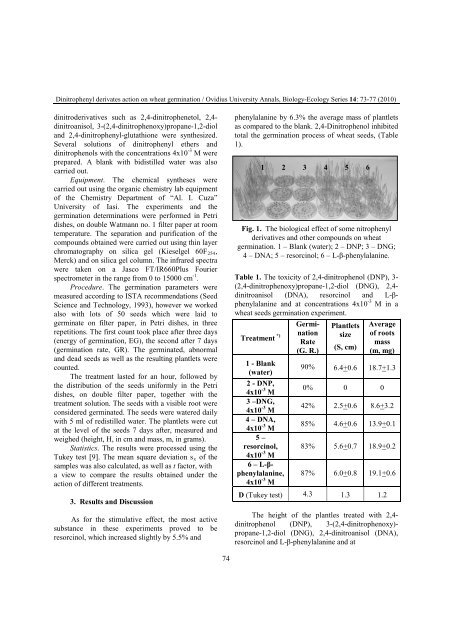VOLUM OMAGIAL - Facultatea de Ştiinţe ale Naturii şi Ştiinţe Agricole
VOLUM OMAGIAL - Facultatea de Ştiinţe ale Naturii şi Ştiinţe Agricole
VOLUM OMAGIAL - Facultatea de Ştiinţe ale Naturii şi Ştiinţe Agricole
Create successful ePaper yourself
Turn your PDF publications into a flip-book with our unique Google optimized e-Paper software.
Dinitrophenyl <strong>de</strong>rivates action on wheat germination / Ovidius University Annals, Biology-Ecology Series 14: 73-77 (2010)<br />
dinitro<strong>de</strong>rivatives such as 2,4-dinitrophenetol, 2,4dinitroanisol,<br />
3-(2,4-dinitrophenoxy)propane-1,2-diol<br />
and 2,4-dinitrophenyl-glutathione were synthesized.<br />
Several solutions of dinitrophenyl ethers and<br />
dinitrophenols with the concentrations 4x10 -3 M were<br />
prepared. A blank with bidistilled water was also<br />
carried out.<br />
Equipment. The chemical syntheses were<br />
carried out using the organic chemistry lab equipment<br />
of the Chemistry Department of “Al. I. Cuza”<br />
University of Iasi. The experiments and the<br />
germination <strong>de</strong>terminations were performed in Petri<br />
dishes, on double Watmann no. 1 filter paper at room<br />
temperature. The separation and purification of the<br />
compounds obtained were carried out using thin layer<br />
chromatography on silica gel (Kieselgel 60F254,<br />
Merck) and on silica gel column. The infrared spectra<br />
were taken on a Jasco FT/IR660Plus Fourier<br />
spectrometer in the range from 0 to 15000 cm -1 .<br />
Procedure. The germination parameters were<br />
measured according to ISTA recommendations (Seed<br />
Science and Technology, 1993), however we worked<br />
also with lots of 50 seeds which were laid to<br />
germinate on filter paper, in Petri dishes, in three<br />
repetitions. The first count took place after three days<br />
(energy of germination, EG), the second after 7 days<br />
(germination rate, GR). The germinated, abnormal<br />
and <strong>de</strong>ad seeds as well as the resulting plantlets were<br />
counted.<br />
The treatment lasted for an hour, followed by<br />
the distribution of the seeds uniformly in the Petri<br />
dishes, on double filter paper, together with the<br />
treatment solution. The seeds with a visible root were<br />
consi<strong>de</strong>red germinated. The seeds were watered daily<br />
with 5 ml of redistilled water. The plantlets were cut<br />
at the level of the seeds 7 days after, measured and<br />
weighed (height, H, in cm and mass, m, in grams).<br />
Statistics. The results were processed using the<br />
Tukey test [9]. The mean square <strong>de</strong>viation sx of the<br />
samples was also calculated, as well as t factor, with<br />
a view to compare the results obtained un<strong>de</strong>r the<br />
action of different treatments.<br />
3. Results and Discussion<br />
As for the stimulative effect, the most active<br />
substance in these experiments proved to be<br />
resorcinol, which increased slightly by 5.5% and<br />
74<br />
phenylalanine by 6.3% the average mass of plantlets<br />
as compared to the blank. 2,4-Dinitrophenol inhibited<br />
total the germination process of wheat seeds, (Table<br />
1).<br />
1 2 3 4 5 6<br />
Fig. 1. The biological effect of some nitrophenyl<br />
<strong>de</strong>rivatives and other compounds on wheat<br />
germination. 1 – Blank (water); 2 – DNP; 3 – DNG;<br />
4 – DNA; 5 – resorcinol; 6 – L-β-phenylalanine.<br />
Table 1. The toxicity of 2,4-dinitrophenol (DNP), 3-<br />
(2,4-dinitrophenoxy)propane-1,2-diol (DNG), 2,4dinitroanisol<br />
(DNA), resorcinol and L-βphenylalanine<br />
and at concentrations 4x10 -3 M in a<br />
wheat seeds germination experiment.<br />
Treatment *)<br />
1 - Blank<br />
(water)<br />
2 - DNP,<br />
4x10 -3 M<br />
3 –DNG,<br />
4x10 -3 M<br />
4 – DNA,<br />
4x10 -3 M<br />
5 –<br />
resorcinol,<br />
4x10 -3 M<br />
Germination<br />
Rate<br />
(G. R.)<br />
Plantlets<br />
size<br />
(S, cm)<br />
Average<br />
of roots<br />
mass<br />
(m, mg)<br />
90% 6.4+0.6 18.7+1.3<br />
0% 0 0<br />
42% 2.5+0.6 8.6+3.2<br />
85% 4.6+0.6 13.9+0.1<br />
83% 5.6+0.7 18.9+0.2<br />
6 – L-βphenylalanine,<br />
4x10 -3 M<br />
87% 6.0+0.8 19.1+0.6<br />
D (Tukey test) 4.3 1.3 1.2<br />
The height of the plantles treated with 2,4dinitrophenol<br />
(DNP), 3-(2,4-dinitrophenoxy)propane-1,2-diol<br />
(DNG), 2,4-dinitroanisol (DNA),<br />
resorcinol and L-β-phenylalanine and at





